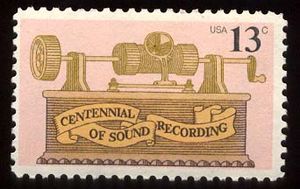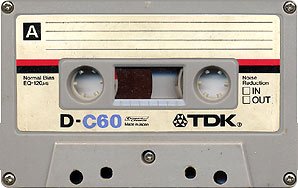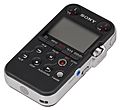Sound recording facts for kids

Sound recording is how we save sound so we can listen to it again later. It's like taking a picture, but for sounds! A special machine captures sound waves. It then turns these waves into electrical signals or digital data.
These signals or data are stored on different things called recording media. Think of gramophone records, cassette tapes, compact discs, or even computer hard drives. To hear the sound again, the machine simply reverses the process.
Most recordings are of music, people talking or singing, and sound effects. We use them for fun, like listening to songs. They are also important for science and history. The ways we record sound have changed a lot over time.
Contents
How We Record Sound: Old and New Ways
Sound is recorded onto different materials using various methods. These methods have changed a lot since people first started recording sounds.
Early Mechanical Recording: The Phonograph
The very first machines for recording sound were mechanical. They didn't use electricity. Thomas Edison invented the phonograph in 1877.
A phonograph has a spinning cylinder. This cylinder is covered in a soft material like tin foil or wax. When sound waves hit a small needle, it vibrates. As the cylinder spins, the needle carves the shape of the sound waves into the soft coating. This groove becomes the recording of the sound.
To play it back, another needle traces the groove. This makes the needle vibrate again. These vibrations are then made louder, so you can hear the sound. A big problem with the phonograph was that it was hard to make copies of the cylinders.
Flat Discs: The Gramophone Record
Making copies became easier with the gramophone. This was invented around 1888. The gramophone works much like the phonograph. But instead of a cylinder, it uses a flat disc record. The needle carves grooves into this disc as it spins.
Because the record was flat, copying was much simpler. The original recording could be pressed onto a plate. This plate then made many copies. Early records were made of rubber or shellac. Later, they were made of vinyl.
Records used to spin at 78 rotations per minute (rpm). As technology got better, records could spin slower. This meant they could play for longer. Later, 45 rpm records became common. By the late 1900s, most records spun at 33 rpm.
Magnetic Tape: Recording on Reels and Cassettes
In the late 1930s, the tape recorder appeared. Tape recorders use a magnetic tape to store sound. Sound waves are turned into an electrical signal inside the recorder. This signal goes to a "recording head." The head changes the tiny magnets on the tape.
As the tape moves past the head, its magnetic particles are arranged. This creates a pattern that represents the sound wave. These magnetic patterns are like the grooves on a record.
When you play a tape, it moves past a "playback head." This head reads the magnetic patterns. It turns them back into an electrical signal. This signal then becomes sound.
A magnetic tape has several "tracks." Each track can hold a different recording. A two-track tape has one track on each half. Most tape recordings today are stereophonic (or "stereo"). This means they have two tracks meant to be played together. One track plays on your left side, and the other on your right. This matches how your two ears hear.
Early tapes were on large reels. They were called "reel to reel" tapes. These are still used by some professionals. But for home use, smaller tapes became popular in the 1970s. Cassettes are small cases with two reels inside. They have a four-track tape that can move in two directions. This gives you "side A" and "side B."
Eight-track tapes were also popular for a while in the 1970s. They work like cassettes, but the tape is a loop. It repeats after playing all the way through. Eight-tracks are not common anymore.
Professional tape systems can have even more tracks. This allows people to mix the sounds in different ways. There's also quadraphonic recording. This uses four tracks to play four different sounds at once. It can make music sound very "real."
Digital Audio Tape (DAT)
Tape recording was used early on to store digital information for computers. As computer technology got better, so did magnetic tape. In the 1980s, Digital Audio Tape (DAT) came out.
DAT works like a cassette. But its magnetic patterns store digital data, not sound vibrations directly. This digital data is a digital audio recording. It can be copied and used with many computer systems. DAT is more complex, but also more flexible. It's used for many types of data, not just sound.
Compact Discs (CDs)
The compact disc (CD) was created in the 1980s. It was a new way to sell digital music recordings. Like DAT, a CD stores data, not direct sound vibrations. It was made to be cheap to produce but still offer high-quality sound. CDs have also been used for many other data storage needs. Like DAT, you need computer technology to record and play CDs.
By the 1990s, CDs had mostly replaced cassettes and records for commercial music. Today, CDs are still popular. But "online" digital recordings like MP3s are becoming even more common.
How Recordings Are Made: Techniques
The first ways of recording sound involved recording a live performance directly. This was a mechanical process. It was often called "acoustical recording." The sound from the performers was captured by a special part called a diaphragm. A cutting needle was connected to it. This needle then made the grooves in the recording material.
To make this work well, the diaphragm was at the end of a cone. Performers had to stand close to the other end of the cone. If someone was too loud, they had to move back. This kept them from making the other performers too quiet. For example, in early Jazz recordings, a block of wood was sometimes used instead of a bass drum.
Using electricity for recording changed things. It allowed microphones to capture sound. Big record labels started using electric microphones in 1925. Most other companies followed by the end of the decade. Electrical recording made things more flexible and improved sound quality. However, if a mistake was made during the performance, the whole recording was still ruined.
Electrical recording also made "over-dubbing" possible. This means recording one part, then playing it back while recording another part, and saving both onto a second disc. The first records using over-dubbing came out in the late 1920s. But overdubbing became much more useful with analog audio tape. Les Paul was a pioneer in using tape for overdubbing. He called it "sound on sound" recording. This way, performances could be built up over time.
The analog tape recorder made it possible to erase or record over mistakes. Another great thing about tape was that you could cut it and join it back together. This allowed for editing the recording. Pieces could be removed or rearranged.
The invention of electronic instruments, like keyboards and synthesizers, also changed recording. MIDI became very important. For example, using MIDI timecode, different equipment can "trigger" or start without someone having to press a button at the exact moment of recording.
More recently, computers (digital audio workstation) are used a lot in recording studios. They make cutting and looping sounds much easier. They also allow for instant changes, like copying parts, adding effects, and rearranging sections of the recording.
Images for kids
-
Frances Densmore recording Blackfoot chief Mountain Chief on a cylinder phonograph in 1916.
-
Singer Tatjana Angelini recording the Swedish voice of Snow White in Snow White and the Seven Dwarfs in 1938.
See also
 In Spanish: Grabación y reproducción de sonido para niños
In Spanish: Grabación y reproducción de sonido para niños











